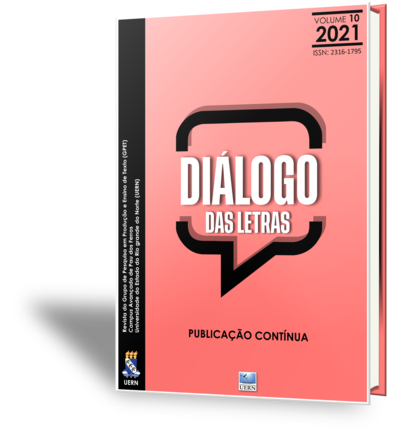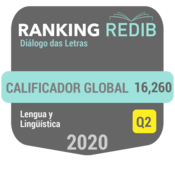Interface entre Escrita Criativa e Letramentos Acadêmicos no ensino de escrita na universidade
DOI:
https://doi.org/10.22297/2316-17952021v10e02134Keywords:
Letramentos Acadêmicos, Escrita Criativa, Ensino de escrita na graduaçãoAbstract
This article arose from questions about what to teach, in the curricular component Portuguese Language, offered as a non-specific subject, in the initial years of several undergraduate courses. In addition to the fact that there are no explicit didactic guidelines regarding this teaching - at least, not in the degree of detail that can be seen in the National Curriculum Parameters for Elementary and Secondary Education - there are the well-known complaints about students"™s difficulties whit reading and writing. In this work, we defend that the teaching of Portuguese Language should assume its role as a means of enabling the student to autonomously manage their ways of learning and producing knowledge, constituting a discipline of teaching writing (and reading) in line with the culture of the various general and specific disciplines, which constitute whatever the area of "‹"‹knowledge in which the higher education is inserted. To achieve this goal, we propose an interdisciplinary articulation between two different approaches to teaching writing: Creative Writing and the Academic Literature model, so that this articulation can result in a pedagogical practice that fosters the development of writing and reading competence. academic texts. We believe that the interface between the precepts of Creative Writing and that of the academic literacy model can provide significant contributions to answer the question about what to teach in the Portuguese Language curriculum component in the initial years of undergraduate courses in different areas, without prejudice to levels. subsequent educational activities.
Downloads
References
AMABILE, L. R. O fantasma, o elefante e o sótão: apontamentos sobre a escrita criativa na academia. Cenários, Porto Alegre, n. 9, p. 53-61, 2014.
BARTHES, R. Escritores e escreventes. In: BARTHES, R. (org.). Crítica e verdade. Tradução: Leyla Perrone Moisés. São Paulo: Perspectiva, 2013. p. 31-39.
BENEDICT, H. The famous writing schools. The New Yor Times, 23/05/1982. Disponível em: https://www.nytimes.com/1982/05/23/books/the-famous-writing-schools.html Acesso em: 10 maio 2021.
DAWSON, P. Creative writing and te new humanities. London; New Yor: Routledge, 2005.
FISCHER, A. Sentidos situados em eventos de letramento na esfera acadêmica. Educação – Revista do Centro de Educação, v. 35, n. 2, p. 215-228, 2010.
GRANDO, D. A Escrita Criativa no contexto do ensino de literatura: inovação pela prática. Anais do X Congresso Ibero-Americano de Docência Universitária (CIDU). Porto Alegre: EDIPUCRS, 2018.
KAVACAMA, E. B. Fragmentos de um discurso acadêmico. 2001. Tese de Doutorado (Programa de Estudos Pós-Graduados em Educação: Psicologia da Educação, Pontifícia Universidade Católica de São Paulo. São Paulo: 2001.
LEA, M. R; STREET, B. V. Student writing in higher education: na academic literacies approach. Studies in Higher Education, v. 23, p. 157-172, 1998.
LEA, M. R.; STREET, B. V. Writing as academic literacies: understanding textual practices in higher education. In: CANDLIN, C. N., HYLAND, K. (org.). Writing: texts, processes and practices. London: Longman, 1999. p. 62-81.
LEA, M. R.; STREET, B. V. O modelo de letramentos acadêmicos: teoria e aplicações. Filol. Linguíst. Port., v. 16, n. 2, p. 477-493, jul./dez. 2014.
LOCNEY, K. Creative across the Curriculum: creative writing beyond English. English Drama Media, p.43-46, 2012.
MACVEAN, K. E. Expansion and inclusion of creative writing: a course for academic writers. Trabalho de conclusão de curso (2016). Disponível em; https://libres.uncg.edu/ir/asu/listing.aspx?styp=ti&id=21425. Acesso em 12 de maio de 2021.
MANCELOS, J. de. O ensino da Escrita Criativa em Portugal: preconceitos, verdades e desafios. Actas do IELP, março de 2010.
MANCELOS, J. de. Um pórtico para a Escrita Criativa. Pontes &Vírgulas: Revista Municipal de Cultura, v. 2, n. 5, 14-15, 2007.
MANCELOS, J. de. Introdução í escrita criativa. 4. ed. Lisboa: Colibri, 2013.
MARINHO, M. A escrita nas práticas de letramento acadêmico. Revista Brasileira de Linguística Aplicada, v. 10, n. 2, p. 363-386, 2010.
PASQUOTTE VIEIRA, E. A. Letramentos acadêmicos: (re)significações e (re)posicionamentos de sujeitos discursivos. 262 f. TESE de Doutorado. Instituto de Estudos da Linguagem da Universidade Estadual de Campinas. Campinas: 2014.
RODRIGUES, F. L. F. A produção de texto na perspectiva da escrita criativa. Diálogo das Letras, v. 4, n. 1, p. 5-13, 2015.
SENA-LINO, P. Curso de escrita criativa I. 3. ed. Porto: Porto Editora, 2013.
SIQUEIRA, Y. P. B. Oficina literária de Escrita Criativa. 128 f. DISSERTAÇíO de Mestrado. Programa de Pós-Graduação em Letras da Universidade Federal do Espírito Santo, 2016.
STREET, B. V. Literacy in theory and practice. Cambridge: Cambridge University Press; 1984.
STREET, B. V. Social literacies: critical approaches to literacy development, ethnography and education. London: Longman, 1995.
ZANELLA, A. V. Atividade criadora, produção de conhecimentos e formação de pesquisadores: algumas reflexões. Psicologia e Sociedade, v. 16, n. 1, 135-145, 2004.
Downloads
Published
How to Cite
Issue
Section
License
Copyright (c) 2021 Diálogo das Letras

This work is licensed under a Creative Commons Attribution 4.0 International License.
A Diálogo das Letras não se responsabiliza por conceitos e opiniões emitidos pelos autores, tampouco manifesta, necessariamente, concordância com posições assumidas nos textos publicados. Além disso, os dados e a exatidão das referências citadas no trabalho são de inteira responsabilidade do(s) autor(es). Ao submeterem seus trabalhos, os autores concordam que os direitos autorais referentes a cada texto estão sendo cedidos para a revista Diálogo das Letras; ainda concordam que assumem as responsabilidades legais relativas às informações emitidas.


















